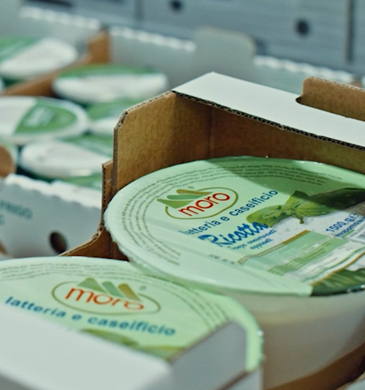Share
Main Conclusions
The Argos Index® has stabilized at 9.9x EBITDA
The Argos Index® is slightly up in Q2 2023 at 9.9x EBITDA and back to its Q4 2022 level. It is stable over the last 3 quarters, although below its last 5 years average of 10.2x, and 1.7x EBITDA lower than its Q2 2021 peak.
The Index stabilization in Q2 is due to strategic buyers’ renewed M&A activity and increased price paid for acquisitions: multiples paid bounced back to 9.6x EBITDA, in line with equity markets’ upturn. This contrasts with private equity funds’ decline in both activity and multiples paid, at 10.3x EBITDA.
Overall, prices for the mid-market were not to affected by the macroeconomic environment of persistent inflation, continued interest rates hikes, and a euro zone on the brink of a recession. They were not affected either by the M&A cycle reversion: Euro zone mid-market M&A activity was down 30% in value and 15% in volume (number of transactions) the 1st semester 2023 (vs. H2 2022), although number of transactions have stabilized in Q2 vs. Q1 2023.
Indeed, the sellers’ price has not yet adjusted to the new environment, and
the gap with buyer’s expectations usually takes time to adjust in periods of market reversal.
Tensions build up in the market which is still very polarized (as in Q1): the price divergence between the upper and lower mid-market is down at 3.6x
EBITDA but still at a high level; and the proportion of multiples at extreme levels (<7x or >15x EBITDA) represents 48% of the deals in Q2, its highest level on record.
Mid-market Argos Index®
Median EV/EBITDA multiple on a six-month rolling basis

Source: Mid-market Argos Index© / Epsilon Research
Index resistance driven by the bounce of multiples paid by strategic buyers
Multiples paid by strategic buyers bounced back to 9.6x EBITDA this quarter. Listed buyers benefited from the 2023 upturn in public equity markets(1). Large corporates, with better financial results than anticipated(2), continued to look for attractive growth opportunities to transform their business models on the face of structural changes.
Multiples paid by investment funds continued their slow decline: they are down 1% at 10.3x EBITDA, while the number of LBO transactions is down 3% in Q2 2023, and 22% comparing H1 2023 with H2 2022. Both private equity activity and prices were impacted by the continued interest rates rise, higher borrowing and refinancing costs, and lower leverage.
As strategic buyers have taken the lead on the mid-market, and funds are more on a wait-and-see mode, prices paid are converging. However there is still a significant gap (of 0.7x EBITDA) : funds seem more selective and favor higher quality assets at higher prices.
(1) The EURO STOXX® TMI Small is up 6.1% since 01.01.2023.
(2) Eurozone large corporates net margin was 8.5% on average in March 2023 vs. 7.2% in 2019,
Source: Refinitiv in Agefi/Dow Jones
Enterprise value / historical EBITDA
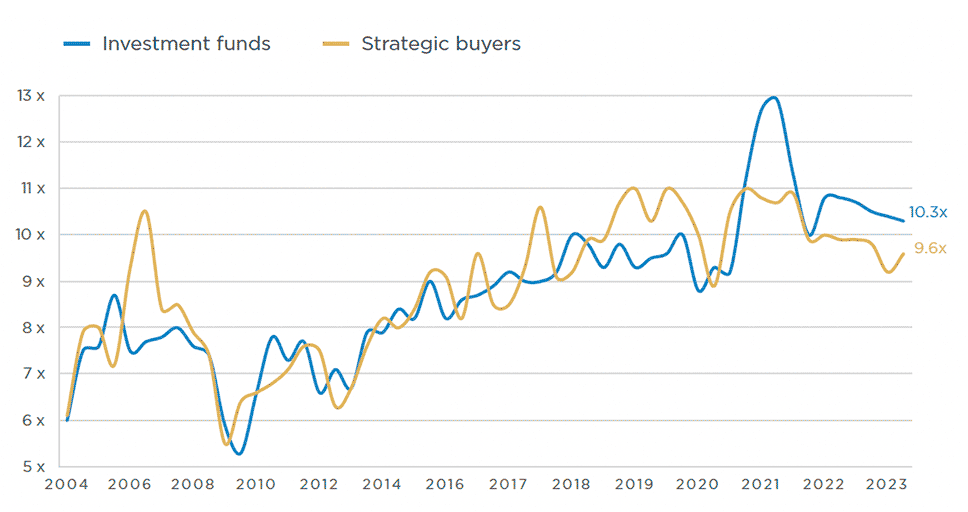
Source: Mid-market Argos Index© / Epsilon Research
Record proportion of transactions at extreme multiples
48% of the transactions in Q2 2023 are at multiples < 7x or > 15x EBITDA, which is the highest level recorded to date. 22% of the transactions are at multiples > 15x EBITDA, up from the five previous quarters. Accordingly, 26%, or every fourth transaction, is trading below 7x EBITDA. But the proportion of multiples > 20x EBITDA is at a record low (2% of deals): indeed, most are deals between 15x and 17x EBITDA.
Share of transactions at multiples >15x EBITDA Argos Index® sample
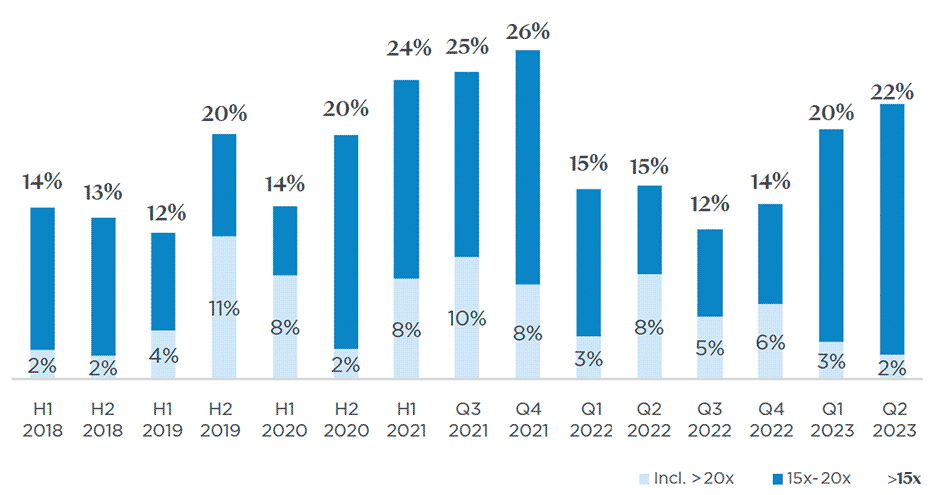
Source: Mid-market Argos Index© / Epsilon Research
The share of transactions at multiples < 7x EBITDA accounts for 26% of analysed transactions, its highest level recorded.
Share of transactions at multiples 15x EBITDA Argos Index® sample
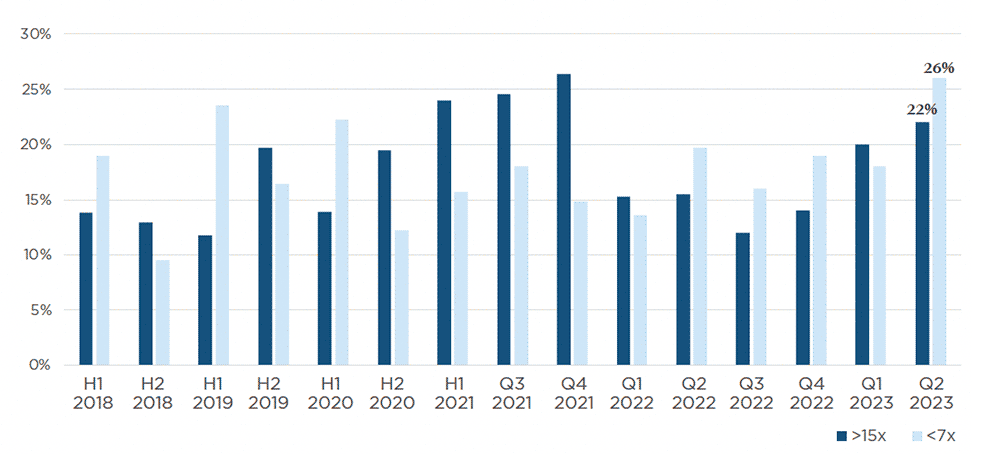
Source: Mid-market Argos Index© / Epsilon Research
Share of transactions at extreme multiples (15x EBITDA)
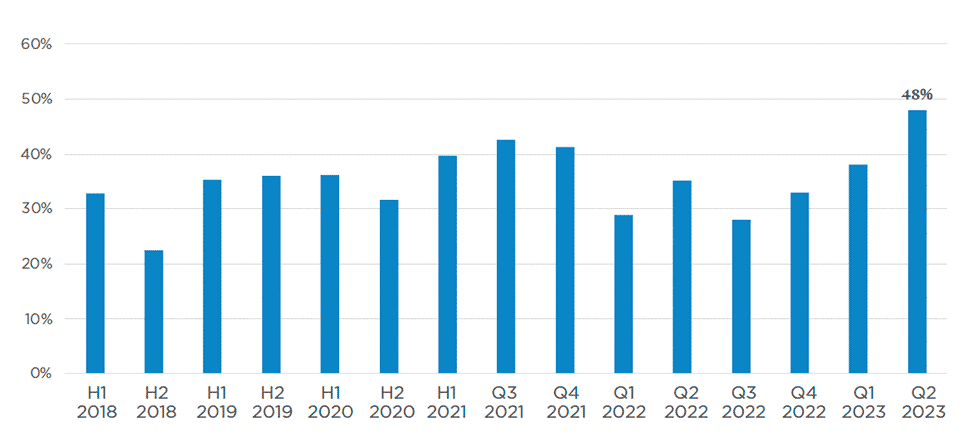
Share of transactions at extreme multiples (<7x and >15x EBITDA)
Source: Mid-market Argos Index© / Epsilon Research
Mid-market M&A activity has stabilized at a low level
Euro zone M&A activity is down 30% in value and 15% in volume (number of deals) on the 1st semester 2023 vs. H2 2022, pulled by the upper segment (€150m-€500m) that decreased by 45% in value and 20% in volume.
The upper mid-market fall is in line with the global M&A market, which dropped 38% in value in H1 2023 to $1.3tn(1). The M&A activity is impacted by the macroeconomic environment: inflation still at record level, pursuit of the interest rates hikes by the ECB(2), recession in the Euro zone(3) as the war in Ukraine fuels continued uncertainty on the continent.
However, the mid market M&A activity has stabilized this quarter: the deal number is up 2% vs. Q1 2023, and 32% in disclosed value (from a very low level). The M&A mid-market is pulled by smaller deals, which continues to prove more resilient and less volatile than the global market.
(1)Source: Refinitiv in the FT, 01.07.2023
(2)The ECB has increased rates 7 times since summer 2022.
(3)Euro zone GDP was down 0.1% in both Q1 and Q2 2023 according to Eurostat.
Eurozone mid-market activity (€15-500m) in volume and value
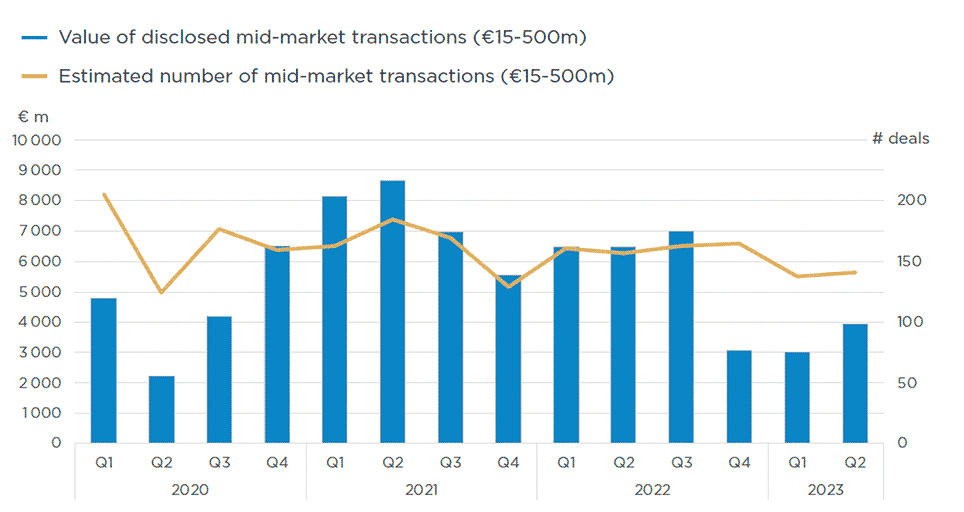
Source: Epsilon Research / MarketIQ
Eurozone Mid-market - Number of deals

Source: Epsilon Research / MarketIQ
Private equity funds activity continued to decline, and their share(1) in Q2 mid-market M&A is at a record low level, below 15% in both number of deals and value.
Share of LBO in Eurozone Mid-market M&A

Share of LBO in Eurozone Mid-market M&A
Source: Epsilon Research / MarketIQ










